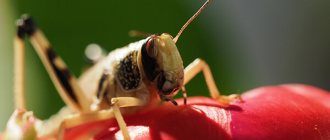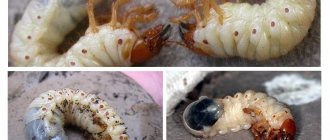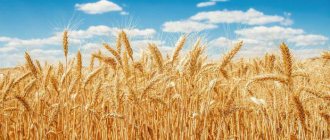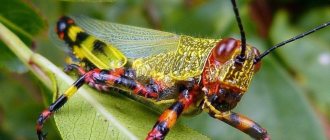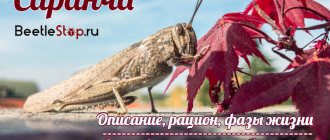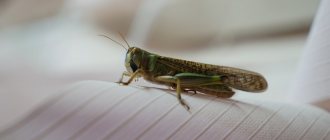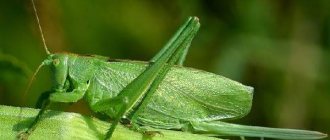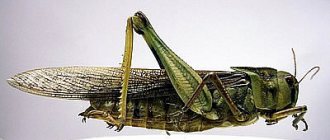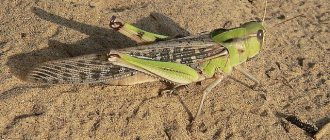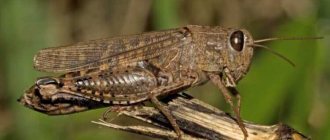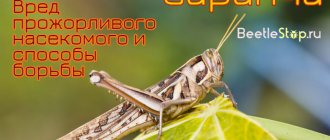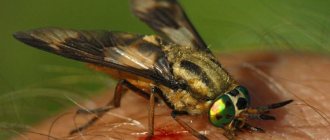- Description of locusts
- Habitats and food
- How to fight locusts, effective methods
- Differences between locusts and grasshoppers
Not everyone knows what locusts are. However, this arthropod insect, which belongs to fairly large representatives of the order Orthoptera, can completely destroy crops. And it is the main threat to grain crops, vegetable plants and other cultivated plants.
In past centuries, after the invasion of these insects from the family of true locusts, fields were left completely bare. Their gluttony was described in the works of many ancient writers. But over time, effective methods have been found to combat these pests.
What locusts look like, what plants they damage and how to fight them - all this will be discussed below.
Description of locusts
Many have heard about how huge hordes of locusts literally destroyed the entire crop in the fields in a matter of minutes. What does this pest look like?
The body length of this voracious insect can range from 4.5 to 19.5 cm, its hind limbs are bent at the “knees”, and these limbs are much larger than the middle or forelimbs.
A pair of hard elytra cover half-transparent wings, almost invisible when folded. Sometimes the wings can be covered with patterns.
The antennae of this insect are short, much smaller than others. The head is larger than that of other individuals of this family, the eyes are larger than average.
Male locusts make specific sounds, how do they do it? It turns out that there are serrations on the thighs of the locust's hind limbs, and thickenings on the elytra. These parts rub against each other, resulting in a chirping sound that can vary in sound.
The body color of pests does not depend on their genes, but solely on the environment in which the locust lives. And even one offspring that grew up in different regions may have different body colors. Also, the color of the body can be determined by the shape of its development.
Young males and females can be bright emerald, yellow, gray or brown, which allows the pests to camouflage themselves among the surrounding vegetation. They also have pronounced differences by gender.
When individuals enter the gregarious phase of their development, their colors are already the same for all insects, and it is also impossible to distinguish them by gender. A flock of these insects moves briskly: these pests cover up to 100-115 km per day.
Reproduction
Mating of pests in a favorable climate can occur from 5 to 12 times a year .
After mating and fertilization, the female lays eggs in the soil , from which larvae will be born after 2 weeks - smaller copies of adult insects.
In the section on locust reproduction you can see photos of insect eggs and larvae.
Habitats and food
Various species of this pest can be found in almost any region of the globe (except the South Pole). Some species live in thickets of grass next to any bodies of water.
Others prefer desert or semi-desert climatic zones; they live in rocky areas where shrubs or grass grow.
What do locusts eat and how much can they eat? While the insect lives alone, its appetite is small. If an individual lives in one place, then it eats no more than 200-250 g of food of plant origin in its entire life.
But the locusts' appetite increases significantly the moment these pests flock together. The flock, flying along green spaces, eats everything in its path. After its invasion, bare earth remains without signs of any vegetation. Moreover, the flock usually stops for food in the morning and evening hours.
A swarm of these pests has no preferences in food - they destroy with the same appetite both thickets of reeds and reeds, as well as fruit trees and vineyards.
They also destroy plantings of any grain crops. During long flights, these insects can destroy weaker relatives, making up for the lack of food and water.
conclusions
Based on a detailed comparison, a number of conclusions can be drawn. Insects belong to different families. Locusts are herbivorous insects in their feeding method, and grasshoppers are true predators. Despite this, grasshoppers are beneficial to humans, but locusts are a source of great problems for agriculture. The former are active in the evening and night hours. The latter move during the daytime. The whiskers and paws of grasshoppers are better expressed. The locust's abdomen is more elongated than that of the grasshopper. The locust does not have an ovipositor, but the grasshopper does.
How to fight locusts, effective methods
In areas where there is a high probability of these pests appearing in large numbers, deep plowing of the soil is usually carried out to destroy the eggs laid by the locusts in the ground.
In the spring, repeated digging and harrowing should be carried out in order to destroy clutches of eggs that the locusts could lay after autumn plowing.
During the summer season, swarms of locusts can only be effectively controlled using chemical agents.
In areas where a large number of larvae of this insect are found, pesticides are used, the validity of which is at least a month from the moment of spraying. To poison the soil and destroy pests, Karate, Confidor and similar preparations are usually used. Also suitable for combating locusts are chemicals designed to kill the Colorado potato beetle.
A systemic chemical such as Clotiamet VDG, when sprayed, protects plants from locust attacks for 19-22 days. The main positive quality of this product is the possibility of using it together with mineral fertilizers, growth stimulants or other drugs that protect plantings from pests.
The insecticide "Damilin", which is also successfully used to combat locust larvae, slows down the development of insects at this stage, and also prevents the formation of the chitinous cover of the larvae, which leads to the death of the pests. This drug is the least toxic.
External differences
The main external difference between insects is the size of the limbs and whiskers.
Insects also differ in head type. In pests it is rectangular, inactive, with powerful jaws, while in predators the head is small, oblong, with sharp jaws.
The locust's body is longer than that of the grasshopper (the predator's abdomen is wider at the sides).
Mustache length
The grasshopper has long antennae that rise above its head. The length reaches half the body, or even more. The whiskers of predators are endowed with a functional feature: they are responsible for orientation in space, and are also an organ of touch.
Unlike grasshoppers and crickets, the length of the whiskers located on the body of locusts is much shorter. In pests they are small, the length does not exceed half of the body. The mustache does not have a functional feature and is a decorative addition.
Limbs
Another difference is the limbs:
- In predators they are longer than in herbivorous pests. The presence of massive hind limbs allows grasshoppers to make large jumps, which is necessary when hunting insects. The serrated forelimbs help to grab the prey.
- Herbivorous pests have very weak forelimbs; they are designed to support the body when moving on their hind legs. Despite the hind limbs being shorter and weaker than those of the grasshopper, the locust is capable of making large jumps.
Ovipositor
- and the order of egg laying:
- The female predator lays eggs using a sword-shaped ovipositor located behind the body in various hidden places: tree bark, stems of shoots, plants, etc.
- The female pest has a spiny-type ovipositor located at the end of the body. The eggs are hidden directly in the soil. Laying occurs in the summer-autumn period, the female pest makes a hole where she hides the eggs. With the help of secretory fluid secreted from the gland, the empty space between them is filled, thereby providing protection to future offspring. The hardened ovipositor (pod) takes the shape of a tube. A female locust is capable of producing several clutches, after which she dies. In favorable conditions, pests are able to lay eggs all year round; the number of clutches reaches 8 times a year.
Who is bigger?
The locust is larger than the grasshopper, sometimes several times. Thus, an adult pest has a body length of 3 cm and reaches a size of up to 8 cm, while a predator, on average, has a length of 2.5 to 4 cm (green and gray grasshopper).
Differences between locusts and grasshoppers
Many people believe that grasshoppers and locusts are very similar to each other. However, these insects have very serious differences that should be discussed. What is the difference between a grasshopper and a locust?
| The main differences between grasshoppers | The main differences between locusts |
| These insects belong to the grasshopper family, suborder of long-whiskered | This pest belongs to the locust family, suborder of the short-whiskered |
| Elongated antennae and limbs | Antennae and limbs are short |
| These individuals are predatory insects | Locusts are herbivorous pests, although sometimes their representatives feed on their weakened “comrades” |
| Grasshoppers sleep during the day but are very active at night | Active only during daytime |
| Do not harm cultivated plants | These pests cause enormous damage to agriculture |
| These insects lay their eggs in plant shoots or inside the bark of trees. | The eggs of these pests can be found in the soil or in fallen leaves. |
Unfortunately, it is possible to fight locusts at all stages of their development only with the help of pesticides, which are quite toxic and can accumulate in cultivated plants and the fruits of fruit trees.
Therefore, more attention should be paid to carefully digging up the soil in the autumn and spring to destroy the eggs of this pest.
Kinds
There are several types of locusts, which differ in appearance and size. The name of the giant locust itself suggests that these insects have a record large size - up to 20 cm . The pest lives in the hot climate of South America.
In Russia, green locusts are found everywhere, resembling a grasshopper - an assistant to farmers and gardeners.
The inconspicuous omnivorous Moroccan pest is very dangerous due to its ability to quickly adapt to insecticides and cause great economic damage.
Capable of migrating in search of a climate suitable for reproduction, the desert locust is known for the fact that the amount of greenery consumed by an individual is equal to its weight .
What plants does it affect?
The pest is unpretentious in food, it eats the ground parts of vegetable plants, cereals, melons, and attacks orchards, berry gardens, wild trees, not disdaining reed plants.
Leaves, stems, shoots, even the bark of young trees serve as food.
You can learn more about the taste preferences of the merciless insect in the section devoted to its nutrition.
Interesting! The older an insect gets, the more varied the food it eats becomes. Seasoned individuals are practically omnivorous.
What are they chattering about?
Orthoptera and Hymenoptera make characteristic sounds to attract females. Everyone has their own sound apparatus. Due to its development in crickets, insects are distinguished by a wider sound range. By their chirping one can judge not only the mating process. Insects also make sounds while protecting their territory.
To listen to the chirping of crickets, you only need to go out of town. They can sing at any time of the day until they wait for their mate. Cicadas require warm weather. The hotter it is outside, the more actively they sing. Therefore, the chirping of these insects is more likely to be heard on a hot summer day.
Differences between crickets and cicadas can be found in the way they chirp. The acoustic organ of crickets is represented by a special structure of the elytra. The principle of their operation is similar to playing the violin. The elytra have a large number of veins and folds, which are arranged in a chaotic manner. When they hit each other, certain vibrations are created that can be heard by the human ear.
Cricket
Their opponents' ability to play music is also their weapon. The sound volume of insects can reach even 100 dB.
Characteristic sounds are heard due to the presence of special membranes located at the base of the abdomen. The chirping sound is produced by the vibration of an acoustic organ.
You can determine who is chirping: cicadas or crickets by the strength of the sound. In the former, the strength of the chirping can even drown out a loud conversation of a person and they can be recognized at a distance of about 800 m. The latter have a more subtle, but multifaceted sound.
Self-defense
Tarantulas have many methods of self-defense that help them escape from enemies. Some species of these spiders threateningly raise the front part of the body and limbs, while opening the chelicerae, taking up a defensive position. Other species turn their backsides towards their enemies, and if they come into direct physical contact, spray them with a pungent-smelling liquid.
We suggest you familiarize yourself with: What a mole cricket and its larva look like
In some cases, they use their limbs to extract delicate hairs from the abdomen, which then rise towards the enemy. These hairs contain small notches with poison. If contact occurs between the hairs and the opponent's eyes or skin, he will immediately feel severe pain. Tarantulas use this tactic against striped skunks, raccoons and coatis that dig them out of their burrows.
Spiders also resort to similar actions when meeting or coming into contact with lizards, frogs and birds hunting spiders that have left their safe hiding place. The mortal enemy of tarantulas are wasps, namely the road wasp; other types of insects can also harm them a lot. This wasp stings the spider in the tuloba (thoracic nerve ganglion), after which the paralyzed spider, placed in the wasp hole, becomes food for its larvae. Tarantulas from Africa, Australia and Asia are aggressive and often use their venom.
(2 ratings, average 4 out of 5)
